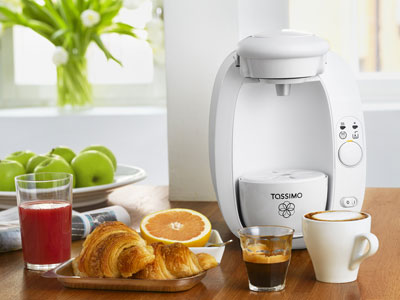Everything you need to know about capsule coffee makers
We independently test the products and technologies that we recommend.

All or almost all of us love coffee, but few people think about the quality of this drink. Most people drink instant coffee because it's the cheapest and it's easy to make. That's just the taste of such a drink is far from a real espresso. However, you do not need to go to the homeland of this drink — to Italy to drink delicious and fragrant coffee. It can be obtained at home and in the office using a good coffee maker. We have already written about the main types of such equipment, and now we will talk about capsule models.
Such machines prepare one espresso in about 1 minute. The cooking process is reduced to turning on the machine, installing the capsule in a special compartment, pressing the "Start" button and waiting for about a minute... and your coffee is ready! This is very convenient when you are in a hurry to work in the morning and want to cheer up with a cup of strong and fragrant drink. Another advantage is that you can get different drinks from capsules. So, if guests have come to you, then you can please them not only with the usual espresso, but also latte, cappuccino, etc.
The care of such machines is also automated. The device will give you a signal when you need to descale it with a special capsule. This procedure is performed (lasting about an hour) about once every six months. Unless, of course, you use bottled or filtered drinking water. But it is not necessary to clean the machine from the coffee itself, like other types of models — used capsules are thrown away and do not dirty the device. It is only necessary to wipe the brewing compartment with a cloth (where the capsules are inserted). You also need to periodically fill the tank with water, which (in some cars) you will also receive a signal about. Although the water container is usually transparent and its contents are easy to monitor.
So, the advantages of capsule machines:
- ease of use;
- high cooking speed;
- minimal care is required;
- several types of drinks; the price of machines is lower than that of automatic models.
And their disadvantages:
- the relatively high cost of capsules and, accordingly, portions of coffee;
- premium automatic machines make espresso tastier;
- dependence on certain types of capsules.
Such machines appeared on our market only a few years ago, although they have been available in Western countries for almost 30 years. The first capsule machines were created by the Swiss company Nestle in 1986 and are sold under the brand name Nespresso. Since then, several systems with different capsules and coffee machines have been developed, and TASSIMO (appeared in 2004) and Nescafé Dolce Gusto (2006) systems are popular on the Ukrainian market. The TASSIMO system includes machines from the German manufacturer Bosch, and capsules for it are produced by partners of Kraft Foods (USA) under different trademarks. Jacobs coffee capsules, manufactured in Germany by Mondelez, are presented on the Ukrainian market. By the way, they are also called T-disks, because they have the shape of round disks. The Dolce Gusto system includes Krups and Delonghi coffee machines, and Nestle capsules (manufactured at the RPC factory in France). We sell Krups models.
 |
| Machines and capsules of Nescafé Dolce Gusto |
TASSIMO or Nescafé Dolce Gusto?
Which coffee is better — TASSIMO or Nescafé Dolce Gusto? There are a lot of similar topics on forums, discussions on social networks and discussions in the comments on the Internet, but there is no exact answer. As usual, the audience is divided into two camps – some praise TASSIMO, others Nescafé Dolce Gusto. At the same time, there are very few people who have tried both types of coffee, but there are many who praise their choice without trying an alternative.
 |
| TASSIMO machine and the fresh coffee she made |
And if supporters of other types of coffee makers pull up, then the discussion becomes hot, like freshly brewed espresso. The owners and supporters of premium cars Saeco, De'Longhi, Jura stand out in particular. Here is their typical comment: a capsule machine is not serious, but real connoisseurs buy models with a built-in coffee grinder. However they "forget" to add that good automatic machines are expensive, need care, etc. Although, they are right when they say that capsule coffee is expensive, and if you drink this drink often (for example, 2 people in the morning and evening for a cup — it turns out 4 servings a day), then buying an automatic car pays off over time.
As a result, the question posed by us remains open. Of course, it's good to personally try both types of coffee to make a choice. For example, you can treat yourself to coffee from friends. And if you are not lucky with this, then the choice comes down to consumer factors. It is worth considering the cost of the types of drinks they prepare, and the convenience of buying capsules where you live. And, of course, it plays the role of which coffee you like best — Jacobs or Nescafe.
Types of TASSIMO and Nescafé Dolce Gusto coffee
There are several dozen types of drinks for TASSIMO machines, including tea and hot chocolate. 5 types of Mondelez coffee are freely available in Ukraine: espresso (16 servings of small volume in a pack), cafe cream (16 servings of medium volume), latte macchiato (8 servings of large volume), latte macchiato, caramel (8 servings of large volume), as well as hot chocolate from Milka (8 servings of medium volume). But capsules with Carte Noire coffee and Twinings teas are difficult to find here and they are not sold in supermarkets.
 |
| Types of TASSIMO coffee drinks |
Even more types of drinks are produced under the Nescafé Dolce Gusto brand, but only a small part of them can be bought from us. In supermarkets, there are espresso (16 servings of small volume in a pack), lungo (16 servings of small volume), espresso barista (16 servings of small volume), latte macchiato (8 servings of large volume), cappuccino (8 servings of large volume) and hot choccocino (8 servings of large volume). You can also find other varieties on the Internet, for example Americano.
Why do 8 servings come out of the contents of some packs, and 16 from others? Cappuccino, latte and chocolate are prepared from two capsules — together with the usual "milk" is used. And espresso and its derivatives like lungo are prepared from one capsule.
There is an interesting point in comparing the machines of the two systems with each other. TASSIMO machines have an operating pressure of 3.3 bar in the parameters, and Dolce Gusto has 15 bar. That is, like real espresso machines. Only it is worth considering this not as an advantage, but as an advertising move, because the difference in these indicators does not manifest itself in fact. The process of making coffee differs only in that TASSIMO has it 100% automated (you can only add water to make the drink less strong), and Dolce Gusto has to specify the amount of water yourself.
As for the taste of different drinks, we can say that latte is the most successful (almost the same as served in various establishments, although the foam is not so airy and is not suitable for latte art. Chocolate, on the contrary, has few fans (mostly children). And espresso from capsules is better than regular instant coffee, but it is not as fragrant and delicious as baristas do on special machines made of grains.
Where and how much to buy?
TASSIMO and Nescafé Dolce Gusto "consumables" are sold in online stores and in coffee departments in supermarkets - sometimes together, and sometimes you can find only one type. So, before the final choice of the machine, it is worth exploring the range of coffee in the stores where you usually buy products. It is possible that it will be convenient for you to buy one type of coffee and this will tip the scales in his direction.
 |
| Various drinks prepared by the Nescafé Dolce Gusto machine |
"Capsule" drinks are more expensive than other types of homemade coffee. This is the main disadvantage of such machines. On the other hand, so far, even taking into account the rise in price of capsules, a portion of such coffee costs about 2-3 times cheaper than in decent establishments.
Types of TASSIMO and Nescafé Dolce Gusto machines
TASSIMO machines differ in appearance, size and volume of the water tank, and some models have unique "chips". For example, TASSIMO FIDELIA+ has a built-in BRITA MAXTRA water filter, and TASSIMO VIVY is the most compact (its width is 17 cm). The main thing is that they all brew coffee the same taste. It is a rare case when buying a low-cost model guarantees high quality work. The situation is similar for the second system — the differences between Dolce Gusto machines are in design and size, and the quality of coffee is the same for everyone.
Water matters
The taste of coffee depends on the water used for its preparation. It is best to cook it in all types of machines, including capsule ones, from drinking purified water. It can be purchased in supermarkets together with capsules or obtained at home using filters. In addition, you will minimize the appearance of scale, which means that you will have to clean the machine very rarely.
Resume
Capsule coffee makers are optimally suited for those who are not very demanding about the quality of espresso and want to brew lattes and cappuccino. And such advantages as ease of use and minimal care will be appreciated by everyone. In general, it is a good choice for home and office. The main thing is that the purchase of capsules fits into your low-cost and does not cause trouble.
Good coffee makers brew espresso like in a cafe, and cheaper, without the help of a barista and right at home or in the office.
Osmosis filters will provide better purification of drinking water from pollution, harmful impurities, etc.
We have collected five coffee grinders from different price categories and differing grinding technologies/
Side-by-side refrigerators conquer with their capacity, delight with their design and impress with their capabilities.
Five models of kettles with different design, body material and functions.
Articles, reviews, useful tips
All materials
















